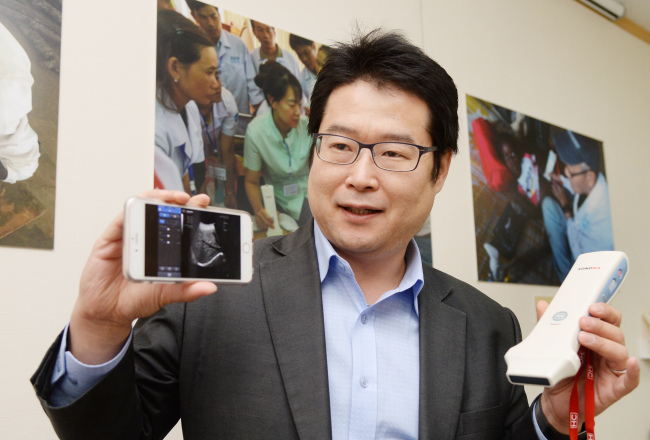[Health-tech Korea] Korea's Healcerion introduces ‘next stethoscope’
By 줄리 잭슨 (Julie Jackson)Published : Feb. 26, 2017 - 17:21
The Korea Herald is publishing a series of articles highlighting South Korea’s promising start-ups in the emerging sectors of digital healthcare and next-generation medical devices. This is the second installment. –Ed.
In the medical world, the stethoscope -- used to listen to the internal sounds of the human body -- has long been a symbolic tool for doctors.
But a Seoul-based startup has come up with a pocket-sized ultrasound imaging device that connects to smartphones and tablets, in the hope that the new medical device, which helps visualize internal complications, could become another basic diagnostic tool for doctors.
“Our goal is to get doctors around the world to use our mobile ultrasound imaging device as readily as they use a stethoscope,” Ryu Jeong-won, the CEO of Seoul-based medical device startup Healcerion, said in an interview with The Korea Herald.
Despite its history and widespread use, the stethoscope can only monitor organs that generate sounds, such as the heart and lungs. To detect other complications such as internal bleeding, doctors must conduct an ultrasound or CT scan using big, immobile machines.
Taking note of this limitation, Healcerion developed a new portable ultrasound imaging device, becoming a pioneer of a new market for mobile medical devices and telemedicine.

Ryu’s idea for a portable mobile ultrasound device came shortly after he finished medical school and began working as a doctor at the emergency room of a local hospital in 2011.
At the ER, Ryu witnessed many cases in which pregnant women or patients with internal complications died while being transported to the hospital. He began to think that things could have turned out differently if it had been possible to conduct an ultrasound scan in an ambulance.
Ryu’s experience and knowledge in engineering, combined with his medical expertise, helped him bring the idea to life.
Before becoming a doctor, Ryu studied physics and electrical engineering at Seoul National University and worked as an engineer before launching a startup that developed digital image storage devices. After that business failed, Ryu, in 2005, joined a local medical school to become a doctor. Seven years later, he once again changed paths, starting a new business -- Healcerion.
“Given my training as both an engineer and doctor, I thought I could build a handheld device that doctors and medical professionals can use to perform ultrasound scans inside a moving ambulance and potentially save more lives,” said the 43-year-old executive.
Healcerion’s main product is the Sonon 300C, a handheld, abdominal ultrasound device that immediately transfers images from a scan to a smartphone or tablet via a wireless network.
It also has two other similar devices -- the Sonon 300L for muscular-skeletal and vascular scans and the Sonon 300MC for animals.
The Sonon 300C, which costs 7 million won ($6,190) and weighs less than 400 grams, is significantly cheaper and more lightweight than conventional ultrasound devices that weigh more than 140 kilograms and cost around three times more.
Conventional ultrasound devices are big and heavy because the machines have to terminate external noise generated by the high voltage electricity used in a scan as well as other sources, he said.
Over the course of three years, Healcerion succeeded in building a smaller ultrasound device that reduces the excess noise to an appropriate level, he said.
Its smaller size and lower price does not mean the Sonon 300C is inferior. The device offers the same fundamental ultrasound imaging capabilities as its traditional counterparts, Ryu said.
“If a conventional ultrasound machine offers image quality akin to a Mercedes-Benz vehicle, our device is like a Hyundai Sonata. Their diagnostic abilities are about the same,” he added.
Both the market and investors have taken note of Healcerion’s potential. The 5-year-old startup has secured around 8.5 billion won from venture capital funds including Softbank Ventures Korea, InterVest and Smilegate.
Sales have been underway since 2015, with revenue growing from 800 million won that year to 1.2 billion won in 2016. Healcerion has sold around 1,000 devices so far, with around half in Korea and half in 30 countries overseas.
In the long run, the Healcerion CEO believes Sonon could become useful in both developing and developed countries. In the former, Healcerion has begun working with international aid organizations to distribute its products to doctors in countries with poor access to health care and medical equipment.
Looking into the future, the doctor-turned-entrepreneur thinks it will take a major rethinking of traditional medical practices to popularize new digital health care devices like Healcerion’s.
“In the end, doctors really love our ultrasound devices, but it’s the hospitals that must see the value in adopting these new technologies,” Ryu said.
By Sohn Ji-young (jys@heraldcorp.com)









![[Kim Seong-kon] Democracy and the future of South Korea](http://res.heraldm.com/phpwas/restmb_idxmake.php?idx=644&simg=/content/image/2024/04/16/20240416050802_0.jpg&u=)







![[KH Explains] Hyundai's full hybrid edge to pay off amid slow transition to pure EVs](http://res.heraldm.com/phpwas/restmb_idxmake.php?idx=652&simg=/content/image/2024/04/18/20240418050645_0.jpg&u=20240418181020)

![[Today’s K-pop] Zico drops snippet of collaboration with Jennie](http://res.heraldm.com/phpwas/restmb_idxmake.php?idx=642&simg=/content/image/2024/04/18/20240418050702_0.jpg&u=)